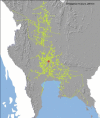Global Spread of Hemorrhagic Fever Viruses: Predicting Pandemics
- PMID: 28986822
- PMCID: PMC7120037
- DOI: 10.1007/978-1-4939-6981-4_1
Global Spread of Hemorrhagic Fever Viruses: Predicting Pandemics
Abstract
As successive epidemics have swept the world, the scientific community has quickly learned from them about the emergence and transmission of communicable diseases. Epidemics usually occur when health systems are unprepared. During an unexpected epidemic, health authorities engage in damage control, fear drives action, and the desire to understand the threat is greatest. As humanity recovers, policy-makers seek scientific expertise to improve their "preparedness" to face future events.Global spread of disease is exemplified by the spread of yellow fever from Africa to the Americas, by the spread of dengue fever through transcontinental migration of mosquitos, by the relentless influenza virus pandemics, and, most recently, by the unexpected emergence of Ebola virus, spread by motorbike and long haul carriers. Other pathogens that are remarkable for their epidemic expansions include the arenavirus hemorrhagic fevers and hantavirus diseases carried by rodents over great geographic distances and the arthropod-borne viruses (West Nile, chikungunya and Zika) enabled by ecology and vector adaptations. Did we learn from the past epidemics? Are we prepared for the worst?The ultimate goal is to develop a resilient global health infrastructure. Besides acquiring treatments, vaccines, and other preventive medicine, bio-surveillance is critical to preventing disease emergence and to counteracting its spread. So far, only the western hemisphere has a large and established monitoring system; however, diseases continue to emerge sporadically, in particular in Southeast Asia and South America, illuminating the imperfections of our surveillance. Epidemics destabilize fragile governments, ravage the most vulnerable populations, and threaten the global community.Pandemic risk calculations employ new technologies like computerized maintenance of geographical and historical datasets, Geographic Information Systems (GIS), Next Generation sequencing, and Metagenomics to trace the molecular changes in pathogens during their emergence, and mathematical models to assess risk. Predictions help to pinpoint the hot spots of emergence, the populations at risk, and the pathogens under genetic evolution. Preparedness anticipates the risks, the needs of the population, the capacities of infrastructure, the sources of emergency funding, and finally, the international partnerships needed to manage a disaster before it occurs. At present, the world is in an intermediate phase of trying to reduce health disparities despite exponential population growth, political conflicts, migration, global trade, urbanization, and major environmental changes due to global warming. For the sake of humanity, we must focus on developing the necessary capacities for health surveillance, epidemic preparedness, and pandemic response.
Keywords: Global biosecurity; Pandemic; Predicting epidemic risk (i.e., pathogenic threat and vulnerability); Viral hemorrhagic fever.
Figures


References
-
- Debré P, Gonzalez JP (2013) Vie et mort des epidémies. O J Med, p 285
-
- Thucydides (2016) The history of the Peloponnesian War (english trans. by Richard Crawley). The Internet classics archive. http://classics.mit.edu//pelopwar.html
-
- Biraben JN (1995) Les maladies en Europe: équilibre et ruptures de la pathocénose. In: MD Grmek (ed) Histoire de la pensée médicale en Occident, t.1, Seuil, 1995, p. 283–310.
Publication types
MeSH terms
LinkOut - more resources
Full Text Sources
Other Literature Sources
Medical
Research Materials
Miscellaneous

